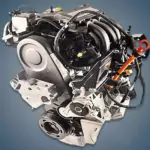The 1.6-liter VW BSE engine was produced in Germany or Hungary from 2005 to 2014 and was installed on a number of mass models of the concern such as Golf, Passat, Touran and Caddy. You can find the BSE motor under the hood of Audi, Volkswagen, Seat and Skoda cars.
The EA113-1.6 series includes: AEH, AHL, AKL, ALZ, ANA, APF, ARM, AVU, BFQ, BGU, BSE, BSF.
In 2005, the 1.6-liter BGU unit was replaced by a similar engine with the BSE index. By design, this is a naturally aspirated engine with an aluminum cylinder block, cast-iron liners, an aluminum 8-valve SOHC cylinder head with hydraulic lifters and a timing belt drive. Fuel injection here is distributed and controlled by an absolute pressure sensor; mechanical thermostat, a pair of lambda probes, as well as a plastic intake manifold with a geometry change system.
Unlike its predecessors, the heat exchanger and EGR valve were abandoned in this engine, but the secondary air pump remained. Some versions of the engine support Euro 5. A dual ignition coil is used here, and the throttle is electrically actuated.
Specifications
| Production years | 2005-2014 |
| Displacement, cc | 1595 |
| Fuel system | injector |
| Power output, hp | 102 |
| Torque output, Nm | 148 |
| Cylinder block | aluminum R4 |
| Block head | aluminum 8v |
| Cylinder bore, mm | 81 |
| Piston stroke, mm | 77.4 |
| Compression ratio | 10.5 |
| Features | SOHC |
| Hydraulic lifters | yes |
| Timing drive | belt |
| Phase regulator | no |
| Turbocharging | no |
| Recommended engine oil | 5W-30 |
| Engine oil capacity, liter | 4.5 |
| Fuel type | petrol |
| Euro standards | EURO 4/5 |
| Fuel consumption, L/100 km (for VW Golf 2007) — city — highway — combined |
9.8 5.6 7.2 |
| Engine lifespan, km | ~400 000 |
The engine was installed on:
- Audi A3 2 (8P) in 2005 – 2013;
- Seat Altea 1 (5P) in 2005 – 2010;
- Seat Leon 2 (1P) in 2005 – 2010;
- Seat Toledo 3 (5P) in 2005 – 2009;
- Skoda Octavia 2 (1Z) in 2005 – 2013;
- Volkswagen Caddy 3 (2K) in 2005 – 2010;
- Volkswagen Jetta 5 (1K) in 2005 – 2010;
- Volkswagen Golf 5 (1K) in 2005 – 2009; Golf 6 (5K) in 2008 – 2013;
- Volkswagen Golf Plus 1 (5M) in 2005 – 2014;
- Volkswagen Passat B6 (3C) in 2005 – 2010;
- Volkswagen Touran 1 (1T) in 2005 – 2010.
Disadvantages of the VW BSE engine
- This is a fairly reliable motor and the main complaints of the owners are related to the oil burner. By a run of 150-200 thousand kilometers, valve stem seals or rings wear out and oil consumption appears. Decarbonizing usually does not help, you have to disassemble the engine.
- The reason for the unstable operation of the engine can be a clogged mesh in the fuel pump, a banal crack in the ignition coil or oxidation of its high-voltage contacts, as well as air leaks through the intake or wedge of the drive system for changing its geometry.
- According to the manuals, the timing belt is replaced every 120,000 km, but if it bursts earlier, the valves will simply bend in the engine. In addition, a water pump hangs on this belt, which can not only wedge, but also leak directly onto the belt, reducing its resource.
- This power unit regularly encounters lubricant leaks from under the valve cover, exhaust manifold cracks between cylinders 3-4, loss of injector tightness, and also destruction of contacts in the connectors of the electric throttle actuator.






